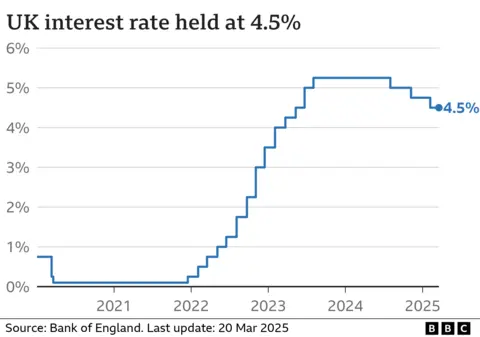When will interest rates go down again and how do they affect mortgages?
 BBC
BBCThe economic uncertainty caused by US President Donald Trump's trade tariffs may mean UK interest rates fall further than expected.
When the Bank of England held interest rates at 4.5% at its last meeting in March, most analysts thought it would cut twice in 2025, but many now anticipate four cuts will take rates down to 3.5%.
Interest rates affect the mortgage, credit card and savings rates for millions of people.
What are interest rates and why do they change?
An interest rate tells you how much it costs to borrow money, or the reward for saving it.
The Bank of England's base rate is what it charges other lenders to borrow money.
This influences what lenders then charge their customers for loans such as mortgages, as well as the interest rate they pay on savings accounts.
The Bank moves rates up and down in order to control UK inflation - which is the increase in the price of something over time.
It has a target to keep inflation at 2%.
When inflation is high, it may decide to raise rates to bring inflation back down.
The idea is to encourage people to spend less and reduce demand.
Once inflation is at or near the target, the Bank may hold rates, or cut them.
What has happened to UK interest rates and will they go down further?
It is difficult to predict exactly what will happen to interest rates. The Bank has to consider whether inflation remains at or below its target, and how the UK economy is doing more generally.
It also pays close attention to the performance of the global economy, which has been thrown into chaos by US tariffs.
The main inflation measure, CPI, was 2.8% in the 12 months to February 2025, down slightly from the previous month.
Although that is far below the peak of 11.1% reached in October 2022, it remains above the 2% target.
After many months of keeping interest rates at a 16-year high of 5.25%, the Bank of England cut them to 5% in August 2024, and again to 4.75% in November. Rates fell again to 4.5% in February, where they stayed in March.

When the Bank cut rates in February, it also cut its growth forecast for the UK economy in 2025.
It said it expected the UK to only narrowly avoid falling into recession - where the economy shrinks for two three-month periods in a row - and predicted that inflation would rise towards 4% later in 2025.
Announcing the decision to hold rates in March, Bank of England governor Andrew Bailey warned about global economic uncertainty but said that he still believed interest rates were on a "gradually declining path".
The Bank was concerned about the possible impacts of increases to the amount of National Insurance paid by employers and the minimum wage, both of which took effect at the start of April.
There are growing fears that the US tariffs could spark a full-blown international trade war, push up prices and fuel inflation around the world - including in the UK.
If that happens and the economy suffers, the Bank may may feel it has to cut rates further than it had planned to do at the start of the year.
Most economists were already expecting a rate cut in May, and now many expect four this year, which would take rates down to 3.5% or below.
How do interest rates affect mortgages, loans and savings rates?
Just under a third of households have a mortgage, according to the government's English Housing Survey.
About 600,000 homeowners have a mortgage that "tracks" the Bank of England's rate, so a base rate change has an immediate impact on monthly repayments.
But more than eight in 10 mortgage customers have fixed-rate deals. While their monthly payments aren't immediately affected, future deals are.
Mortgage rates are still much higher than they have been for much of the past decade.
As of 19 March, the average two-year fixed mortgage rate is 5.34%, according to financial information company Moneyfacts, and a five-year deal is 5.18%. The average two-year tracker is 5.19%.
It means many homebuyers and those remortgaging are having to pay a lot more than if they had borrowed the same amount a few years ago.
About 800,000 fixed-rate mortgages with an interest rate of 3% or below are expected to expire every year, on average, until the end of 2027.
A hold in interest rates may have relatively little impact on pricing of fixed-rate mortgages in the short-term. The outlook is complicated at the moment as the markets, and lenders, consider the impact of the Budget, the upcoming Spring Statement and other global events. However, the prospect of further falls could give impetus to lenders to cut their rates for new borrowers.
You can see how your mortgage may be affected by future interest rate changes by using our calculator:
Credit cards and loans
Bank of England interest rates also influence the amount charged on credit cards, bank loans and car loans.
Lenders can decide to reduce their own interest rates if decisions by the Bank of England make borrowing costs cheaper. However, this tends to happen very slowly.
 Getty Images
Getty ImagesSavings
The Bank of England interest rate also affects how much savers earn on their money.
A falling base rate is likely see a reduction in the returns offered to savers by banks and building societies. The current average rate for an easy access account is 3% a year.
Any cut could particularly affect those who take the interest from savings to top up their income.
What is happening to interest rates in other countries?
In recent years, the UK has had one of the highest interest rates in the G7 - the group representing the world's seven largest so-called "advanced" economies.
In June 2024, the European Central Bank (ECB) started to cut its main interest rate for the eurozone from an all-time high of 4%. After a series of cuts it now stands at 2.5%.
In the US, the central bank - the Federal Reserve - cut rates three times in the latter part of 2024, but held interest rates in March, leaving its key lending rate with a target range of 4.25% to 4.5%.
The Fed also cut its growth forecast as it warned the new US trade tariffs were "clearly" driving up prices.
